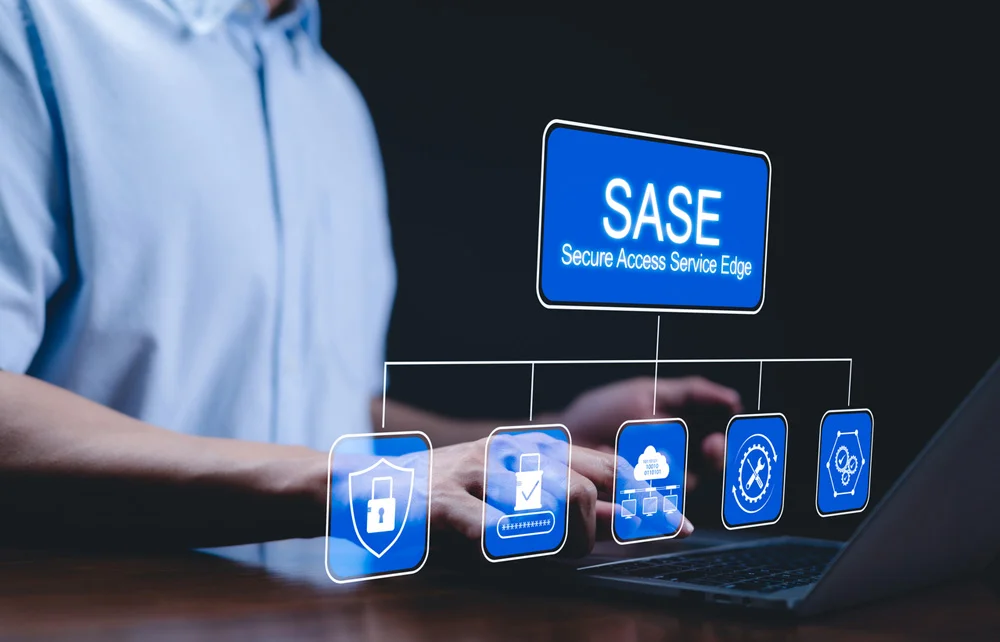SASE and the Future of Secure Remote Work
In today’s ever-evolving business landscape, remote work has swiftly transitioned from a luxury option to an essential operational mode. This change, driven partly by technological advancements and partly by global events, has made the need for secure and efficient remote work environments more important than ever. Enter SASE Solutions, a state-of-the-art technology framework that is set to redefine how organizations manage network and security protocols in a remote-first world.
As the business world embraces remote work, organizations must rethink how they secure and manage access to their digital environments. One solution stands out: SASE (Secure Access Service Edge)—a unified, cloud-based framework that combines network and security functions. As companies shift from traditional office setups to remote-first models, SASE offers the tools needed to keep operations both agile and secure.
Why SASE Matters in the Remote Work Era
The remote work revolution—accelerated by technological growth and global events—has changed the way businesses operate. Once considered optional, remote work is now essential for many organizations. With that shift comes a growing need for reliable, scalable, and secure digital infrastructure.
SASE answers this need. By combining networking and security functions into a single cloud-delivered service, SASE streamlines how businesses protect remote users and their data. This architecture supports real-time monitoring, dynamic access control, and improved network performance—all crucial for a productive remote workforce.
What Is SASE? A Quick Introduction
Secure Access Service Edge (SASE) is an architecture that merges network connectivity with advanced cybersecurity. It integrates components like:
SD-WAN (Software-Defined Wide Area Network): Optimizes network traffic paths for better performance.
Cloud-delivered security tools: Firewalls, secure web gateways, and threat detection—all hosted in the cloud.
Identity-based access controls: Enforce Zero Trust principles by granting access based on user identity and context.
Together, these tools create a seamless and secure environment for remote operations, minimizing the traditional risks of working outside the office.
Key Benefits of SASE for Remote Work
1. Stronger Security Across the Board
SASE is built on Zero Trust principles—every request is verified, regardless of where it’s coming from. It also supports real-time threat detection and cloud-based protections, keeping sensitive data secure no matter where employees log in.
2. Improved Network Performance
By intelligently routing traffic through the most efficient paths, SASE ensures reliable, high-speed connectivity. This is especially important for remote teams that rely on consistent access to cloud applications and data.
3. Scalability and Flexibility
SASE grows with your business. As your remote workforce expands, the platform can scale without the need for major hardware investments or complex reconfigurations.
4. Simplified IT Management
With integrated services under one roof, IT teams can manage both security and networking from a centralized console, reducing complexity and administrative overhead.
Challenges to Consider
While SASE brings powerful benefits, successful implementation requires planning:
Integration with legacy systems can be complex and time-consuming.
Initial investment may be significant, depending on existing infrastructure.
Training and change management are essential to ensure smooth adoption across the organization.
These challenges can be mitigated through phased rollouts and by working with experienced vendors and consultants.
Real-World Applications and Impact
Many companies across industries have already adopted SASE to support remote work. Technology firms, in particular, report:
Fewer network vulnerabilities
Improved performance for distributed teams
Better visibility into user activity and system performance
These outcomes highlight how SASE not only strengthens security but also boosts productivity and user satisfaction.
The Future: Where SASE Is Headed
Looking ahead, SASE is expected to integrate even more advanced technologies, like AI and machine learning, to improve threat detection and automate responses. As remote work becomes the norm, businesses will increasingly rely on SASE to ensure a secure, resilient, and scalable digital environment.
Conclusion: SASE as a Strategic Imperative
SASE isn’t just another IT upgrade—it’s a foundational shift in how organizations approach security and connectivity in the remote age. By unifying network and security into a single cloud-based framework, SASE empowers companies to work securely from anywhere without compromising performance.
As remote and hybrid work models become standard, adopting SASE will be key to staying competitive, agile, and secure in the years ahead.
Frequently Asked Questions
What sets SASE apart from traditional security solutions?
SASE unifies networking and security in a cloud-native architecture, enabling better performance, visibility, and protection—all managed from a single platform.
Is SASE suitable for small businesses?
Yes. SASE provides scalable, cost-effective solutions that help small businesses implement enterprise-grade security without requiring massive infrastructure investments.
What should organizations consider before adopting SASE?
Review existing infrastructure, plan for integration, train staff, and adopt a phased rollout strategy to ensure a smooth and effective transition.








